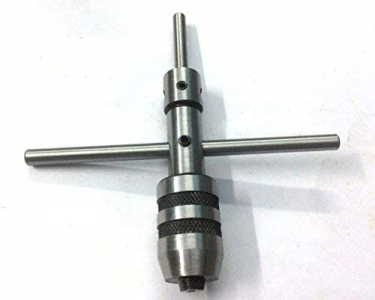I'd like this post to answer the questions on machine tapping that I never come across.
I tap by hand and that has it's own inherent problems, like coming in at an angle, pressing too hard or too softly down into the hole,... One thing though that I always come across while manual tapping is that at some point the turning stops because the extra force needed to continue feels like it will break the tapping bit. When this happens I usually back off a little and then proceed forward. Sometimes I backout completely and I clean the hole and the tapping bit. In the beginning I used to break the tapping bits in the hole. So my first question has to do with that.
How do you control tapping on a mill when the spindle is turning the tapping bit, so that it doesn't break the bit?
More precisely, how does the mill know when to stop when the bit is getting into that dangerous breaking area?
The feeling in my hand signals me to stop when the torque is getting too close to the bit breaking point but how does a mill tell you that?
How does the mill tapping bit get drawn into the hole?
Obviously I don't lock the head of the mill and the piece being tapped is clamped down.
Does the tapping action alone pull the mill head down so the the tapping bit can go further into the hole?
Most of my tapping is done with #6x40 bits. Is that too small for a mill?
I have an LMS micro mill with forward and reverse and variable speed so I guess it's ready for tapping.
I think I'll start with just these few questions. Any and all replies are greatly appreciated.
I tap by hand and that has it's own inherent problems, like coming in at an angle, pressing too hard or too softly down into the hole,... One thing though that I always come across while manual tapping is that at some point the turning stops because the extra force needed to continue feels like it will break the tapping bit. When this happens I usually back off a little and then proceed forward. Sometimes I backout completely and I clean the hole and the tapping bit. In the beginning I used to break the tapping bits in the hole. So my first question has to do with that.
How do you control tapping on a mill when the spindle is turning the tapping bit, so that it doesn't break the bit?
More precisely, how does the mill know when to stop when the bit is getting into that dangerous breaking area?
The feeling in my hand signals me to stop when the torque is getting too close to the bit breaking point but how does a mill tell you that?
How does the mill tapping bit get drawn into the hole?
Obviously I don't lock the head of the mill and the piece being tapped is clamped down.
Does the tapping action alone pull the mill head down so the the tapping bit can go further into the hole?
Most of my tapping is done with #6x40 bits. Is that too small for a mill?
I have an LMS micro mill with forward and reverse and variable speed so I guess it's ready for tapping.
I think I'll start with just these few questions. Any and all replies are greatly appreciated.

